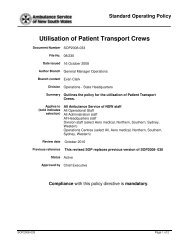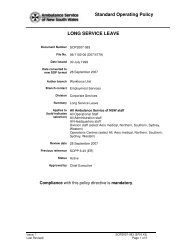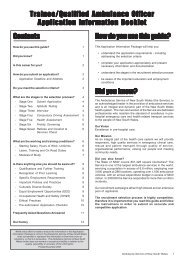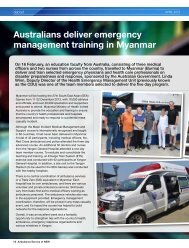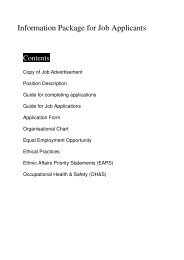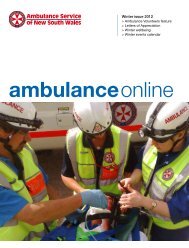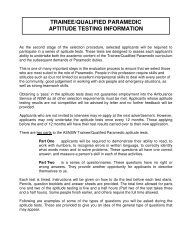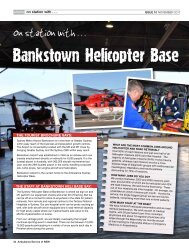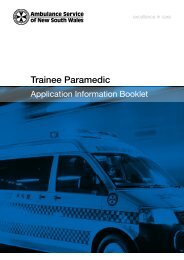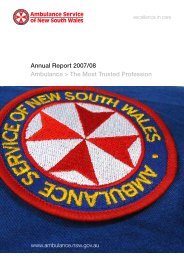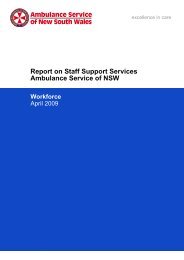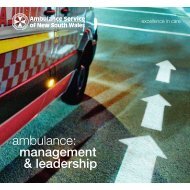atsb final report released 16 may 2013 - Ambulance Service of NSW
atsb final report released 16 may 2013 - Ambulance Service of NSW
atsb final report released 16 may 2013 - Ambulance Service of NSW
You also want an ePaper? Increase the reach of your titles
YUMPU automatically turns print PDFs into web optimized ePapers that Google loves.
winch training at increased height the operations manual required that a comparison<strong>of</strong> the training benefit was to be made with the potential risk to the involvedpersonnel. The conduct <strong>of</strong> winch training that did not involve live winching was notsubject to height constraints. The ACM advised that the majority <strong>of</strong> his live winchtraining was basic winch training. However, his line training and check flights, aswell as a number <strong>of</strong> his currency flights, were <strong>report</strong>ed to have involved advancedwinching at increased height.<strong>Ambulance</strong> <strong>Service</strong> <strong>of</strong> New South WalesRole <strong>of</strong> the Special Casualty Access TeamThe Special Casualty Access Team (SCAT) was developed by the AS<strong>NSW</strong> about30 years ago to enable paramedics to access patients in hazardous or remotelocations. The SCAT training manual described the role <strong>of</strong> SCAT paramedics asfollows:The ultimate role <strong>of</strong> SCAT is to provide ‘Clinical Access’ – the ‘Access,Triage, Treatment & Evacuation’ <strong>of</strong> patients in order to provide medicalcare. SCAT also provides medical oversight <strong>of</strong> the immediate environmentand personnel for the duration <strong>of</strong> a mission.…SCAT skills are unique – not recreational, not rescue, not mountaineering,but ‘Clinical Access’.AS<strong>NSW</strong> management representatives advised that the improved capability <strong>of</strong>helicopters and rescue winches had greatly affected SCAT operations. This hasresulted in the vast majority <strong>of</strong> patients in difficult to access areas now beingretrieved by helicopter rescue winch, rather than via ground rescue teams.SCAT personnel have been involved in a number <strong>of</strong> high pr<strong>of</strong>ile, visuallyspectacular rescues that are well-known within the SCAT paramedic community.This includes the previous rescue that was referred to by the duty paramedic whenplanning to access the injured canyoner. That previous rescue was conducted by adifferent helicopter operator.AS<strong>NSW</strong> management advised that SCAT <strong>of</strong>ficers were trained in access proceduresand in the equipment used for those procedures. That training was adapted to themission at hand on an as required basis. This was the case with the high pr<strong>of</strong>ilemission that was referred to by the duty paramedic when planning to access theinjured canyoner, and involved the application and adaptation <strong>of</strong> existingprocedures and training. However, the AS<strong>NSW</strong> <strong>report</strong>ed that the earlier rescue wasextensively risk managed and included the use <strong>of</strong> a command and control systemunder the supervision <strong>of</strong> an accredited rescue agency.A number <strong>of</strong> SCAT paramedics advised that several missions over the years hadused innovative patient retrieval methods that involved the adaptation <strong>of</strong> skillslearnt during training. In respect <strong>of</strong> the plan to retrieve the injured canyoner,AS<strong>NSW</strong> management considered that the use <strong>of</strong> a self-stabilising system and themethod used to deliver the winch hook were both innovative as they were neitherdocumented nor trained for, and had not been previously undertaken. Whileacknowledging that a level <strong>of</strong> innovation <strong>may</strong> be required to complete missions, theuse <strong>of</strong> those techniques was considered by AS<strong>NSW</strong> management to be beyond the- 32 -



